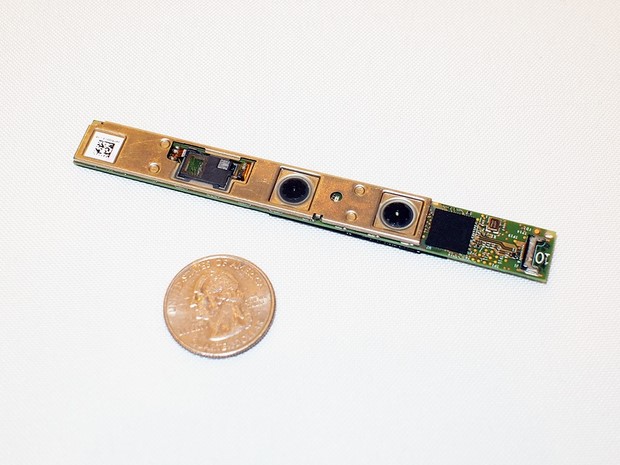Intel Showcases RealSense 3D Camera Apps, Devices, Cutting-Edge User Interfaces At New York Event
Intel gathered a number of software developer and hardware manufacturing partners together this week in New York to showcase the latest technologies and innovations that Intel's RealSense 3D camera technology can enable. From new interactive gaming experiences to collaboration, 3D mapping and gesture control, the technology holds promise that could someday reinvent how we interact with PCs. The camera technology itself integrates a depth sensor and a full color 1080p HD camera together with standard technologies like dual array mics, but with an SDK, processing engine and 3rd party software that can allow the camera module to sense environmental variables, more like humans do.
The Intel RealSense camera can detect hand gestures down to finger level accuracy, allowing complex control and new user interface techniques. It also understands facial features and movements that can then be processed to determine position and emotion. And finally it can detect foreground, background and other environmental characteristics to allow augmented reality processing and positioning of objects in 3D space.

Intel's RealSense F200, Front Facing 3D Camera module, as found in notebooks and tablets...

Personify - Video Conferencing With "A Hint of Teleportation"
Intel's RealSense F200, Front Facing 3D Camera module, as found in notebooks and tablets...
The technology is similar to what Microsoft developed with their Kinect sensor for the Xbox but it's significantly smaller and in some ways, more advanced for desktop PC and mobile computing applications. We've previously shown you a bit of what the rear-facing RealSense camera could do in Dell's Venue 8 7000 series tablet. But the star of Intel's event in NYC was the RealSense F200 front-facing module with real-time tracking and video capabilities, that's incorporated into notebooks and all-in-one systems. The rear-facing module in the Dell Venue 8 tablet is only for stills.
Personify - Video Conferencing With "A Hint of Teleportation"
As you can see in the video, Personify's video conferencing app was probably the most impressive demo we saw that day. It's actually a very cool, useful and efficient way to hold a video conference meeting or heck, maybe even a webcast. With the Personify app and an Intel RealSense-enabled machine, you can have up to five people on a web conference (current limitation) and as you can see their head shots are overlaid on to your desktop. From there, any person in the conference can share a window, application, video stream, their entire desktop or whatever they're running on their machine with any individual on the call of for all to see. We think we should use this for our "Two And A Half Geeks" webcast, yes? We'd be stylin' and oh-so geeky.
One of the other things the F200 RealSense module enables is quick, inexpensive 3D mapping. In one of the demos at the event, 3DSystems was showing off their 3DMe app and service, which makes it quick and easy to make 3D models from virtually anything scanned with the RealSense camera. Someone's face, for instance, can be scanned in just a few seconds and mapped onto a 3D model for animations or even printed in a 3D printer. The 3DMe service even offers customers the ability to have 3D models of themselves, mapped onto various characters, to be printed and painted--some of hte models are visible in the image above. And if you'd like to see our very own Marco Chiappetta as a Klingon, check this out.
Representatives from the Food Network were on hand to show off the RealSense integration that recently launched on their website. Part of the RealSense software are browser plug-ins that let web developers leverage the camera's capabilities on-line. Food Network has integrated gesture and voice controls on their site that allow users to browse and view numerous recipes, play video tutorials, start timers, and scroll up and down the page, without even touching their systems.
There were also a number of game developers on hand showing off their wares. Choice Provision's upcoming title "Laserlife" was one of the more innovative on hand. In the section of the game we were shown, the player is flying through space and encounters a dead, human astronaut. And by using various gestures and flying through the astronauts synapses, the player is able to piece together and ultimately manifest the astronaut's memories. Definitely watch the video on this page to see this game in action--it's an original concept to say the least.
Many of the applications we've shown you here are available, or will be available soon, in the Intel RealSense App Showcase. Though, you'll need a system with an Intel RealSense camera to take full advantage of them.


